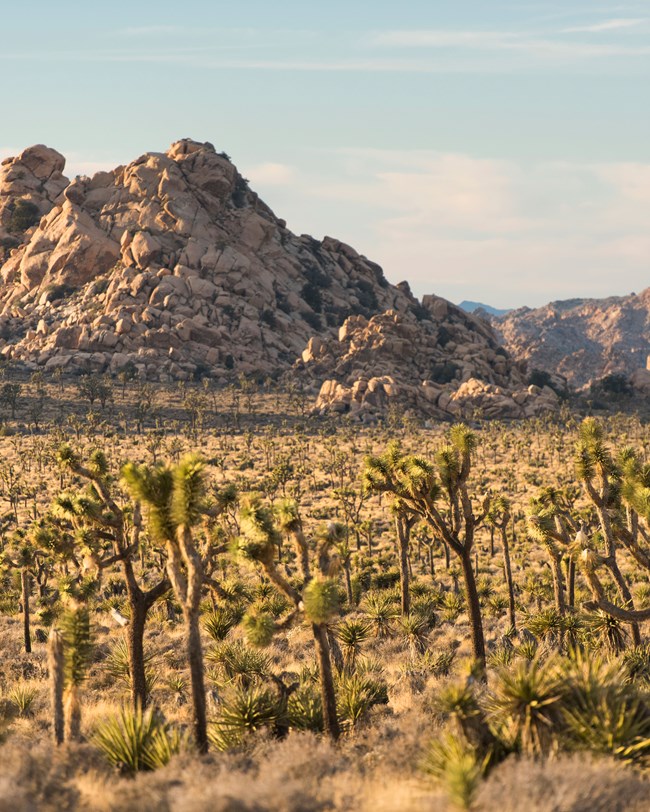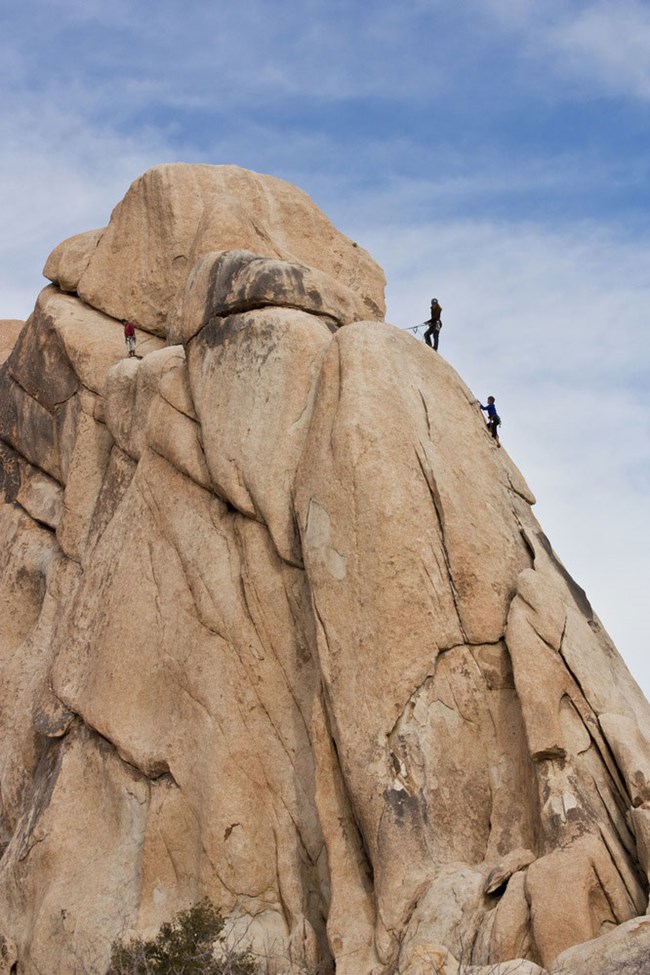Last updated: July 9, 2024
Article
NPS Geodiversity Atlas—Joshua Tree National Park, California
Geodiversity refers to the full variety of natural geologic (rocks, minerals, sediments, fossils, landforms, and physical processes) and soil resources and processes that occur in the park. A product of the Geologic Resources Inventory, the NPS Geodiversity Atlas delivers information in support of education, Geoconservation, and integrated management of living (biotic) and non-living (abiotic) components of the ecosystem.

Introduction
Joshua Tree National Park (JOTR) is located approximately 160 km (100 mi) east of San Diego and the Los Angeles metropolitan area in Riverside and San Bernardino Counties, southern California. The park unit was proclaimed a national monument on August 10, 1936 and redesignated a national park on October 31, 1994. JOTR preserves approximately 319,959 hectares (790,636 acres) of sand dunes, dry lakes, flat valleys, rugged mountains, granitic monoliths, and oases. Several mountain ranges are found within or along the boundaries of the park: the Pinto Mountains on the northern boundary; the Coxcomb Mountains in easternmost JOTR; the Eagle Mountains in southeastern JOTR; the Cottonwood Mountains on the southern boundary; the Little San Bernardino Mountains on the southwestern boundary; and the Hexie Mountains in the central part of the park (Tocci et al. 2018). The park is home to a fascinating, diverse biological community representative of both the Mojave and Colorado desert ecosystems, and was designated a Biosphere Reserve in 1984.
Geologic Setting
The geologic history of Joshua Tree National Park records the effects of plate tectonics, volcanism, mountain-building, and stark erosion. The bedrock geology of the park is represented primarily by crystalline igneous and metamorphic rocks of several time intervals, with significant sedimentary units limited to approximately the past 10 million years (Tocci et al. 2018). The oldest rocks in the park date back to the Proterozoic Eon at 1.7–1.4 billion years old and consist of metamorphic rocks that have been intruded and altered by subsequent igneous activity. Within JOTR there are at least five different bodies of igneous rock; the oldest of which rival the metamorphic rocks in age, and the youngest only tens of millions of years old. Overall, the geologic time periods best-preserved at JOTR include the Paleoproterozoic Era, Mesoproterozoic Era, Mesozoic Era, and Miocene Epoch to present (Tocci et al. 2018).
Regional Geology
Joshua Tree National Park lies at the eastern terminus of the Transverse Ranges wiithin the Pacific Border Physiographic Province. The Transverse Ranges are unusual in that they trend east-west rather than north-south as do most ranges. The Transverse Ranges province extends about 325 miles from Point Arguello and San Miguel Island on the west coast of California to the Coxcomb Mountains in Joshua Tree on the east (Norris and Web, 1976). Principal mountain ranges include the Little San Bernardino Mountains to the southwest, the Pinto, Cottonwood, and Hexie Mountains in the central part, and the Eagle and Coxcomb Mountains on the east end. Elevations are generally between 2,000 to 4,000 feet. The highest point is 4,562 feet at Twentynine Palms Mountain.
- Scoping summaries are records of scoping meetings where NPS staff and local geologists determined the park’s geologic mapping plan and what content should be included in the report.
- Digital geologic maps include files for viewing in GIS software, a guide to using the data, and a document with ancillary map information. Newer products also include data viewable in Google Earth and online map services.
- Reports use the maps to discuss the park’s setting and significance, notable geologic features and processes, geologic resource management issues, and geologic history.
- Posters are a static view of the GIS data in PDF format. Newer posters include aerial imagery or shaded relief and other park information. They are also included with the reports.
- Projects list basic information about the program and all products available for a park.
Source: NPS DataStore Saved Search 2912. To search for additional information, visit the NPS DataStore.
A NPS Soil Resources Inventory project has been completed for Joshua Tree National Park and can be found on the NPS Data Store.
Source: NPS DataStore Saved Search 2984. To search for additional information, visit the NPS DataStore.

Related Links
Related Articles
Joshua Tree National Park
National Park Service Geodiversity Atlas
The servicewide Geodiversity Atlas provides information on geoheritage and geodiversity resources and values within the National Park System. This information supports science-based geoconservation and interpretation in the NPS, as well as STEM education in schools, museums, and field camps. The NPS Geologic Resources Division and many parks work with National and International geoconservation communities to ensure that NPS abiotic resources are managed using the highest standards and best practices available.
